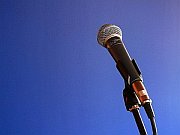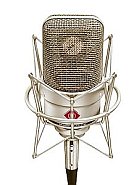Beginner information about dynamic and condenser microphones
Remember there are two types of microphones targeting a bit of different applications:
1.) Dynamic microphones – the most common type of microphones we see. It is used as a vocal microphone for most live performances especially that the most popular dynamic microphones for vocals is Shure SM58LC Cardioid Dynamic Microphone.The cost of purchasing dynamic microphones is affordable with respect to typical home studio applications.
You can purchase a very good dynamic microphone for vocal studio applications as low as $30. If you need to know about typical technical specifications for SM 58, you can read it here:
http://www.shure.com/proaudio/products/wiredmicrophones/us_pro_sm58-cn_content
2.) Condenser microphones – this is an ultra-sensitive microphone commonly used for professional studio applications, commonly found in big and professional A class studios. Typical condenser microphones cost a lot, a vintage Neumann U47 cost around $5500. A much more practical and affordable is Neumann TLM 49 Condenser Studio Microphone which you can buy at Amazon for $1300. You can find some important information about this condenser microphone here: http://www.recording-microphones.co.uk/Neumann-U47-tube.shtml and also here for Neumann TLM 49. These microphones are optimized for vocal recording.
Of course, they have superb reception and frequency response. But one downside is that they are too expensive as beginning gears for any home studio producers. A solution that balances cost and benefit is necessary (more details below).
Is there really a substantial difference between dynamic and condenser microphones? You can hardly tell. Listen to the following produced songs below, all recorded using SM 58:
Sample #1:
Sample #2:
The lessons here is that if you do have the budget and a long term plan building a professional recording studio aiming to get several clients, you need a condenser microphone. If you are just working in your home recording studio with an extremely limited budget while still aiming to produce your first demo, you can just purchase SM-58 and this will get the job pretty well done.
Microphones for recording drums
If you are planning to record drums in your home recording studio; then you need a lot of microphones. For recording drums, it requires at most 3 microphones to sufficient capture the most important drum kit sound. Although with much patience and advantage in room acoustic environment, you can perform recording & mixing drums using only two microphones and still have a great drum sound.
For three-microphone setup, you need:
1.) One microphone (preferably SM57) for snare.
2.) One kick drum microphone (preferably Audix D6)
3.) One overhead microphone (condenser microphone, it can be Rode NT1A).
There are more elaborate methods on putting microphones on drums such as this method on recording drums with 4 mics but you can start with just two or three microphones.
Total Microphones you need to purchase
So based on the above discussions; how many microphones do you really need to purchase? OK let’s break down into a summary with the following assumptions:
Situation A: Recording band live (one vocal, one guitar, one drums, one bass; assuming guitars and bass are recorded via amp)
a.) Two Rode NT1A(One for vocal recording and one for drum overheads)
b.) Two SM57 (one for guitar amplifier and one for snare drum)
c.) Two Audix D6 (one for bass guitar and one for kick drum)
Note: Audix D6 is suitable for very low end bass. If the bass guitar track is somewhat targeting more middle frequencies (such as a bass guitar solo), you might want to pair it with SM57.
Total: 6 microphones needed.
Situation B. Recording band one at a time- drum kit first
a.) One Rode NT1A – shared with drum overheads and vocals
b.) One SM57 – shared with snare drum and guitar amplifer cabinets
c.) One Audix D6 – sharing with bass guitar or kick drums.
Total: 3 microphones needed
Situation C. Singer-songwriter interested in recording vocals and acoustic guitar only
a.) One Rode NT1A – for live recording of acoustic guitar and vocals.
Total: only one microphone needed
Situation D. Recording band live with guitars and basses DI directly into audio interface (no using of amp cabinet)
a.) Two Rode NT1 for drum overheads and vocals
b.) One SM57 – for snare drum
c.) One audix D6 for kick drums
Total: 4 microphones needed
Situation E. Vocalist interested only in live vocal recording
One SM58 microphone needed.
IMPORTANT NOTE: Some situations discussed on the above setup assumes you would only be using one microphone pointing to the guitar amp at any time. In some guitar recording techniques, there are two microphones used. Therefore you need more microphones than what is recommended.
To save the number of microphones, you might want to record the guitars and bass either as DI or use only one microphone per amp. Then you will be recording overdubs for guitars to further thicken the guitar sound.
Content last updated on October 15, 2012


